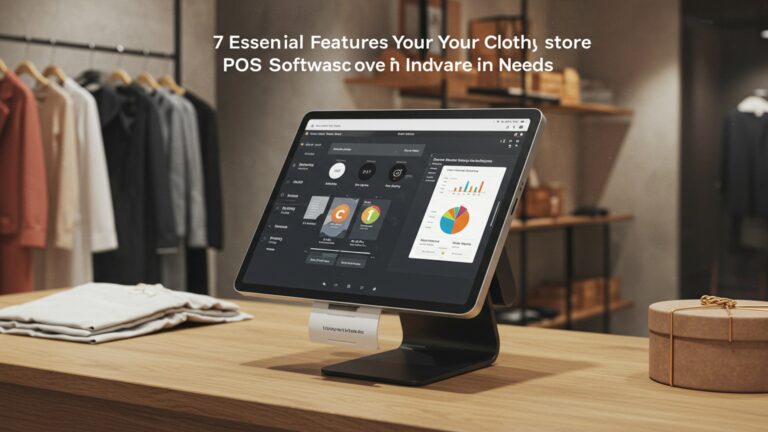10 Essential Ways to Optimize Your Clothing Inventory Management System
In today’s dynamic retail landscape, an optimized clothing inventory management system is not merely an operational tool but a strategic imperative. Businesses grappling with the rapid shifts in consumer preferences, amplified by fast fashion cycles and the rise of sustainable demand, face significant challenges from dead stock to missed sales opportunities. Modern solutions now leverage AI-driven demand forecasting and real-time RFID tracking, transforming the traditional warehouse into a responsive data hub. Mastering these advancements allows retailers to predict seasonal shifts with greater accuracy, reduce carrying costs. enhance the omnichannel customer experience by ensuring product availability across all touchpoints, from e-commerce platforms to brick-and-mortar stores.
Written by PromotoAI
promotoai generate content that ranks

1. Implement Barcode and RFID Technology for Accurate Tracking
At the heart of an optimized clothing inventory management system lies precise tracking. Manual data entry is prone to human error and can significantly slow down operations, leading to discrepancies and lost sales. Modern retailers are increasingly adopting technologies like barcodes and Radio-Frequency Identification (RFID) to revolutionize how they manage stock.
These familiar optical, machine-readable representations of data provide a simple yet effective way to track individual items. Each garment is tagged with a unique barcode, which is scanned at various points in its lifecycle – from receiving to sale. This ensures that every movement is recorded accurately.
Taking accuracy and speed to the next level, RFID uses electromagnetic fields to automatically identify and track tags attached to objects. Unlike barcodes, RFID tags don’t require a direct line of sight to be read, allowing for much faster bulk scanning. Imagine scanning an entire box of apparel in seconds without opening it, or conducting a full store inventory count in minutes instead of hours or days. This capability dramatically reduces labor costs and improves inventory accuracy to near 99% levels, as seen in many leading fashion retailers.
Here’s a quick comparison:
| Feature | Barcode Technology | RFID Technology |
|---|---|---|
| Cost per Tag | Very low | Higher than barcodes |
| Read Range | Line of sight (inches to a few feet) | Non-line of sight (several feet, even through materials) |
| Scanning Speed | One item at a time | Multiple items simultaneously (bulk scanning) |
| Data Storage | Limited (usually a product ID) | More extensive (product ID, serial number, manufacturing date, etc.) |
| Implementation Complexity | Relatively simple | More complex, requires specialized readers and software |
| Ideal Use Case | Smaller businesses, individual item tracking, POS | Large-scale operations, high-volume inventory, rapid cycle counts, supply chain visibility |
For a robust clothing inventory management system, integrating either or both of these technologies is a fundamental step towards operational excellence.
2. Adopt a Cloud-Based Inventory Management Software
Gone are the days of clunky on-premise systems or, worse, spreadsheet-based inventory tracking. A cloud-based clothing inventory management system offers unparalleled flexibility, scalability. accessibility. These systems store your inventory data on remote servers, accessible via the internet from any device, anywhere.
- Real-time Data
- Accessibility
- Scalability
- Cost-Effectiveness
- Automatic Updates & Security
Instantly update and view inventory levels across all your channels – brick-and-mortar stores, e-commerce platforms. warehouses. This prevents overselling or underselling and provides a single, accurate source of truth.
Your team can access the system from anywhere, facilitating remote work, multi-location management. on-the-go decision-making.
As your business grows, cloud solutions can easily scale up or down to meet changing demands without significant infrastructure investment.
Typically offered on a subscription model (SaaS), cloud solutions eliminate large upfront costs for hardware and maintenance.
Providers handle software updates, backups. security, ensuring your system is always current and protected against threats.
Consider a scenario where a popular jacket sells out in your online store. With a cloud-based system, this sale immediately reflects in your physical store’s inventory, preventing a customer from attempting to purchase an item that is no longer available. This seamless integration is critical for customer satisfaction and efficient operations.
3. Regularly Conduct Inventory Audits Through Cycle Counting
Even with the best technology, discrepancies can arise due to theft, damage, incorrect shipments, or human error. Full physical inventory counts are disruptive and time-consuming. A more efficient and less intrusive method for a clothing inventory management system is cycle counting.
Cycle counting involves regularly counting a small, specific portion of your inventory on a rotating basis. Instead of shutting down operations for a massive annual count, you count a few items every day or week. Over time, every item in your inventory will have been counted multiple times. This continuous process helps to:
- Identify Discrepancies Early
- Improve Accuracy
- Minimize Disruptions
- Pinpoint Problem Areas
- Reduce Shrinkage
Catch errors quickly before they accumulate and become major problems.
Frequent checks lead to more accurate stock records.
Business operations can continue uninterrupted.
By analyzing where discrepancies occur most often, you can identify underlying issues in your processes (e. g. , specific warehouse locations, staff training needs).
More accurate inventory means better control over loss due to theft or damage.
For example, a boutique might decide to count all jeans on Mondays, all dresses on Tuesdays. so on. This systematic approach ensures continuous monitoring and refinement of your clothing inventory management system, making it more reliable and proactive.
4. Leverage Data Analytics for Demand Forecasting
Effective inventory management isn’t just about knowing what you have; it’s about predicting what you’ll need. Data analytics is a powerful tool to enhance your clothing inventory management system by providing insights for accurate demand forecasting.
By analyzing historical sales data, seasonal trends, promotional impacts, customer buying patterns. even external factors like economic indicators or fashion trends, you can make more informed decisions about purchasing and stocking. Modern inventory software often includes built-in analytics or integrates with business intelligence tools.
- Optimize Stock Levels
- Strategic Purchasing
- Reduce Markdowns
- Improve Cash Flow
Prevent overstocking (which ties up capital and incurs carrying costs) and understocking (which leads to lost sales and dissatisfied customers).
Identify which styles, sizes. colors are likely to be in high demand, allowing you to negotiate better deals with suppliers for larger, more confident orders.
By aligning inventory with demand, you minimize the need for heavy discounts to clear unsold stock.
Less capital tied up in slow-moving inventory means more available funds for other business investments.
A fashion brand, for instance, might use analytics to predict that floral patterns will surge in spring, while knitwear will peak in winter, allowing them to adjust their ordering cycles well in advance. This proactive approach is a cornerstone of an optimized clothing inventory management system.
5. Streamline Receiving and Put-Away Processes
The moment new inventory arrives is a critical juncture for your clothing inventory management system. Inefficient receiving can lead to delays, errors. misplaced items from the outset. Streamlining these processes ensures accuracy and speed.
- Dedicated Receiving Area
- Standardized Procedures
- Batch Processing
- Immediate Put-Away
- Cross-Docking (where applicable)
Designate a specific, organized space for incoming shipments to prevent clutter and confusion.
Develop clear, step-by-step instructions for receiving staff. This includes checking packing slips against purchase orders, inspecting goods for damage. accurately scanning items into the system.
For large shipments, use batch scanning with barcode or RFID readers to quickly and accurately update inventory counts.
Once received and verified, items should be moved to their designated storage locations as quickly as possible. This reduces the risk of items being misplaced in the receiving area.
For items destined for immediate shipment to customers or other stores, consider cross-docking – moving goods directly from inbound to outbound transportation with minimal storage time – to speed up fulfillment.
A real-world example: A warehouse manager implemented a system where all incoming boxes were immediately scanned with an RFID reader, which automatically verified the contents against the purchase order and updated the inventory system. Any discrepancies triggered an alert for manual inspection. This cut receiving time by 50% and reduced data entry errors significantly.
6. Optimize Warehouse Layout and Storage
The physical organization of your inventory directly impacts the efficiency of your clothing inventory management system. A well-designed warehouse or backroom layout can significantly reduce picking times, minimize errors. improve overall operational flow.
- Logical Layout
- Clear Labeling
- Vertical Space Utilization
- FIFO (First-In, First-Out)
- Path Optimization
Organize items based on demand (fast-movers closer to shipping), size, type (e. g. , all dresses together), or season. Consider a “zone picking” approach where pickers are assigned to specific areas.
Ensure all storage bins, shelves. racks are clearly labeled with location codes. This is crucial for fast and accurate put-away and retrieval.
Maximize vertical space with appropriate shelving and racking systems. Clothing, especially folded items, can be stored efficiently in multi-tiered shelves.
Implement a system that ensures older inventory is sold before newer inventory. This is particularly essential for fashion items that can go out of style or seasonal goods. This prevents dead stock and reduces the need for heavy markdowns.
Design picking routes that minimize travel distance and reduce congestion.
Consider a boutique with limited backroom space. By installing adjustable shelving and organizing items by category and size, they reduced search times for staff by 30% and improved their ability to quickly fulfill online orders, demonstrating the direct impact on their clothing inventory management system’s effectiveness.
7. Integrate with Sales Channels (POS, E-commerce)
For a truly unified and efficient clothing inventory management system, seamless integration with all your sales channels is non-negotiable. This means connecting your inventory software with your Point-of-Sale (POS) system for physical stores and your e-commerce platform(s) for online sales.
- Unified Stock View
- Prevent Overselling
- Enhanced Customer Experience
- Streamlined Operations
- Better Reporting
Every sale, whether in-store or online, immediately updates the central inventory count, providing a real-time, accurate view of available stock across all channels.
Avoid the frustrating situation of selling an item online only to discover it’s already been sold in-store, or vice versa.
Offer “buy online, pick up in-store” (BOPIS) or “ship from store” options, leveraging your entire inventory to fulfill orders faster and more conveniently for customers.
Eliminates manual data entry between systems, reducing errors and saving significant time for staff.
Gain a holistic view of sales performance across all channels, helping you make better strategic decisions.
Many modern inventory management solutions offer native integrations with popular e-commerce platforms like Shopify, Magento. WooCommerce, as well as leading POS systems. This creates a powerful ecosystem where all aspects of your clothing inventory management system work in harmony.
8. Automate Reordering and Vendor Management
Manual reordering is time-consuming and prone to human oversight, leading to stockouts or excess inventory. Automating these processes is a powerful way to optimize your clothing inventory management system.
Modern inventory software can be configured to automatically generate purchase orders when stock levels fall below a predetermined reorder point. This point is calculated based on factors like lead time, demand forecasts. safety stock levels. Some advanced systems can even send these orders directly to suppliers.
- Prevent Stockouts
- Reduce Overstocking
- Save Time
Ensures popular items are always in stock, minimizing lost sales.
Orders are placed only when needed, reducing carrying costs.
Frees up staff from tedious manual tasks.
Good vendor relationships are crucial. Your inventory system can help manage vendor details, purchase history, lead times. performance metrics. This allows you to track supplier reliability and negotiate better terms.
A growing online clothing store set up their inventory system to automatically reorder their best-selling t-shirts when stock hit a 2-week supply. The system generated a purchase order and alerted their primary supplier via email. This automation reduced their stockouts by 80% and allowed the owner to focus on marketing instead of inventory checks.
9. Train Staff Thoroughly on System Usage
Even the most sophisticated clothing inventory management system is only as effective as the people operating it. Inadequate staff training is a common pitfall that can negate all the benefits of technology and process optimization. Investing in comprehensive and ongoing training for all staff members involved in inventory management is paramount.
- System Navigation
- Core Processes
- Error Prevention
- Troubleshooting
- Why it Matters
Ensure everyone understands how to log in, access different modules. perform basic functions.
Train staff on specific tasks like receiving new inventory, fulfilling orders, conducting cycle counts, processing returns. transferring stock between locations.
Educate staff on common errors and how to avoid them (e. g. , double-scanning, misplacing items, incorrect data entry).
Provide basic troubleshooting steps for common issues. clearly define escalation paths for more complex problems.
Explain the importance of accurate inventory data and how their role contributes to overall business success and customer satisfaction.
One fashion retailer found that after implementing a new system, discrepancies actually increased. Upon investigation, it was discovered that staff were skipping essential scanning steps due to a lack of understanding of the system’s purpose. Relaunching with mandatory, hands-on training sessions, including real-world scenarios, drastically improved data accuracy and system adoption.
10. Establish Clear KPIs and Performance Monitoring
To truly optimize your clothing inventory management system, you need to measure its performance. Establishing Key Performance Indicators (KPIs) and regularly monitoring them provides actionable insights into what’s working and what needs improvement.
- Inventory Accuracy
- Stockout Rate
- Inventory Turnover
- Days of Inventory
- Shrinkage Rate
- Order Fulfillment Rate/Time
(Actual Stock / System Stock) x 100%. Aim for 95% or higher.
The percentage of times an item is out of stock when a customer wants to buy it. Lower is better.
Cost of Goods Sold / Average Inventory. Higher turnover generally means efficient sales and less capital tied up.
(Average Inventory / Cost of Goods Sold) x 365. How many days it takes to sell through current inventory. Lower is often better, depending on the product.
(Recorded Inventory – Actual Inventory) / Recorded Inventory. Measures loss due to theft, damage, or error. Lower is better.
The percentage of orders filled completely and the average time taken to fulfill an order.
Regularly reviewing these metrics through dashboard reports provided by your inventory software allows you to identify trends, diagnose problems. make data-driven decisions. For instance, a high stockout rate for a specific product category might indicate a need to adjust reorder points or improve demand forecasting for those items. Continuous monitoring and adjustment are key to sustained optimization.
Written by PromotoAI
promotoai generate content that ranks
Conclusion
Optimizing your clothing inventory isn’t merely about counting items; it’s about mastering the dynamic flow of your business, transforming potential liabilities into assets. By embracing robust systems for demand forecasting and real-time tracking, you move beyond reactive stock management to a proactive strategy. Consider the recent emphasis on sustainable fashion, where accurate inventory minimizes waste – a crucial point for today’s conscientious consumer, aligning profit with purpose. My personal tip? Don’t just track your inventory; assess its story. I once helped a boutique owner drastically cut seasonal overstock by simply correlating local event schedules with specific apparel sales, a nuance often missed by generic software. Implementing these essential practices, from regular audits to leveraging advanced apparel billing software, empowers you to enhance profitability and elevate customer satisfaction. Take the leap to refine your processes; your streamlined operations and thriving bottom line will be your reward.
More Articles
10 Essential Features for Apparel Store Billing Software Success
Boost Your Clothing Store Sales 7 Ways With POS Barcode Scanners
Learn 8 Smart Ways POS Software Streamlines Inventory Management
5 Essential Features Your POS Billing Software Needs for GST Compliance
Written by PromotoAI
promotoai generate content that ranks
FAQs
Why is it such a big deal to optimize my clothing inventory management system?
Optimizing your clothing inventory is crucial because it helps you avoid stockouts of popular items and clear out slow-moving stock, saving you money. It reduces waste, improves cash flow. ultimately makes your customers happier because they can find what they want when they want it.
Where should I begin if I want to make my inventory management better?
A great starting point is to audit your current system. Figure out what’s working and what’s not. Look at your existing processes, any tools you use. where you’re losing money or efficiency. Once you grasp your pain points, you can target specific improvements.
Is investing in new tech like inventory software really worth it for clothing businesses?
Absolutely! Modern inventory management software can automate tracking, provide real-time data. help with demand forecasting. For clothing, this means better size and color assortment planning, faster restocks. a significant reduction in manual errors. It’s a game-changer for efficiency and accuracy.
What’s the best way to ensure my stock counts are always spot on?
Accuracy is key! Implement regular cycle counts instead of just annual checks. Use barcode scanning or RFID for quick and error-free data entry. Train your staff thoroughly on proper receiving, picking. returns procedures. The more consistently you track, the more accurate your numbers will be.
How can I get better at predicting what clothing items will sell well so I don’t get stuck with too much of the wrong stuff?
Demand forecasting for clothing involves analyzing historical sales data, keeping an eye on current fashion trends. understanding seasonal variations. Look at customer purchase patterns, use predictive analytics tools if you have them. pay attention to market signals to make more informed buying decisions.
I’ve got a bunch of old clothes that aren’t selling. How do I deal with dead stock effectively?
Don’t let it just sit! Strategies include running promotions, bundling it with popular items, offering discounts, or even donating it for a tax write-off. The goal is to free up valuable warehouse space and recover some of your investment, even if it’s not full price.
Should I constantly be checking and tweaking my inventory management processes?
Yes, absolutely! Inventory management isn’t a one-and-done task. Regularly review your key performance indicators (KPIs), assess the effectiveness of your strategies. gather feedback from your team. Markets and trends change, so your system should evolve with them to stay optimized.






